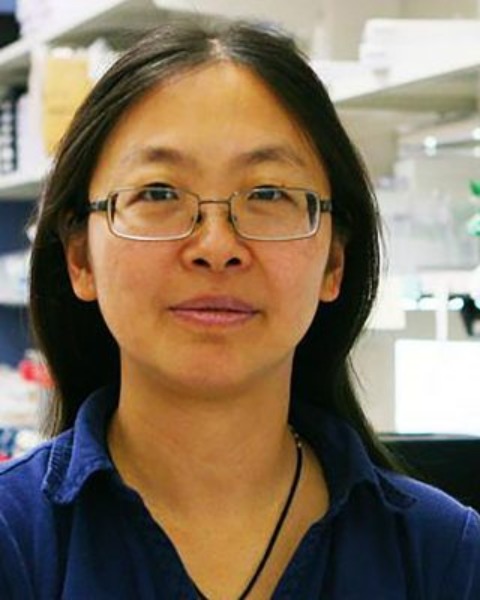Myeloma Genomics and cell signaling
Poster Session 3
P-376: Genomic and transcriptional profiling stratifies myeloma models into two clusters with distinct risk signatures and drug responses
Friday, September 29, 2023
1:15 PM - 2:15 PM EEST

Jing Zhang, PhD
Professor of Oncology
University of Wisconsin-Madison
Madison, Wisconsin, United States
Introduction: Approximately 15-20% of newly diagnosed multiple myeloma (MM) display high-risk features with a poor response to current treatment options and shorter survival than the standard-risk group. Genetic events are used to stratify high-risk MM (hrMM) (e.g. Amp1q). Two hrMM gene signatures, UAMS-70 and EMC-92 (SKY92), have been independently developed and validated to predict poor clinical outcomes. Within the hrMM group, two ultra hrMM subgroups were identified as double hit hrMM (with >2 high-risk cytogenetic abnormalities) and functional hrMM, who did not have hrMM-associated genomic alterations but were refractory to induction therapy or had early relapse within 12 months. These ultra hrMM had an overall worse prognosis than genetically defined hrMM. Clearly, novel approaches are required for treating hrMM, particularly ultra hrMM. However, the lack of mouse models recapitulating hrMM and ultra-hrMM has been a barrier in these challenging settings.
Activation of a human MYC transgene in germinal center B cells induces a highly penetrant, but relatively indolent MM in primary V*MYC mice. Subsequent selection via transplantation and bortezomib (Btz) treatment established transplantable t-Vk*MYC lines (e.g. t-Vk12653) that shows reduced response to Btz in vivo. We recently generated a highly malignant MM mouse model driven by GC expression of hMYC transgene and endogenous NRASQ61R (named “VQ mice”).
Methods: We performed genomic and transcriptomic profiling of MM models using whole exome sequencing, copy number variation analysis, and RNA-Seq.
Results: We report that Group A VQ MM and t-Vk12653 share similar transcriptome and several hrMM features, including hyperproliferation, extramedullary disease, exhaustion of CD4 and CD8 T cells, and partial response to Btz treatment. In comparison to control plasma cells, they express higher EMC-92 hrMM scores but not UAMS-70 hrMM gene signature. Compared to Group A VQ and t-Vk12653 MM models, Group B VQ expresses additional hrMM and ultra hrMM features, including downregulation of Fam46c, expression of UAMS-70 and EMC-92 hrMM gene signatures and Amp1q-associated PBX1-FOXM1 gene signatures, upregulation of cancer growth pathways associated with functional hrMM, and de novo resistance to venetoclax in vitro and to Btz and anti-TIGIT immune checkpoint blockade in vivo. Our results suggest that Group A VQ MM and t-Vk12653 may represent Revised International Staging System (R-ISS) Stage III MM without ultra hrMM, while Group B VQ represent R-ISS Stage III MM with ultra hrMM features. Interestingly, trametinib (Tra), an FDA-approved MEK inhibitor, is the only single agent we tested so far that significantly prolongs the survival of both Group A and B VQ mice. Its survival benefit is only observed in immunocompetent but not in immunodeficient NSG mice, suggesting that Tra functions through an intact immune system.
Conclusions: Our study provides a strong rational to develop Tra-based immunotherapies for treating RAS-driven hrMM and ultra hrMM.
Activation of a human MYC transgene in germinal center B cells induces a highly penetrant, but relatively indolent MM in primary V*MYC mice. Subsequent selection via transplantation and bortezomib (Btz) treatment established transplantable t-Vk*MYC lines (e.g. t-Vk12653) that shows reduced response to Btz in vivo. We recently generated a highly malignant MM mouse model driven by GC expression of hMYC transgene and endogenous NRASQ61R (named “VQ mice”).
Methods: We performed genomic and transcriptomic profiling of MM models using whole exome sequencing, copy number variation analysis, and RNA-Seq.
Results: We report that Group A VQ MM and t-Vk12653 share similar transcriptome and several hrMM features, including hyperproliferation, extramedullary disease, exhaustion of CD4 and CD8 T cells, and partial response to Btz treatment. In comparison to control plasma cells, they express higher EMC-92 hrMM scores but not UAMS-70 hrMM gene signature. Compared to Group A VQ and t-Vk12653 MM models, Group B VQ expresses additional hrMM and ultra hrMM features, including downregulation of Fam46c, expression of UAMS-70 and EMC-92 hrMM gene signatures and Amp1q-associated PBX1-FOXM1 gene signatures, upregulation of cancer growth pathways associated with functional hrMM, and de novo resistance to venetoclax in vitro and to Btz and anti-TIGIT immune checkpoint blockade in vivo. Our results suggest that Group A VQ MM and t-Vk12653 may represent Revised International Staging System (R-ISS) Stage III MM without ultra hrMM, while Group B VQ represent R-ISS Stage III MM with ultra hrMM features. Interestingly, trametinib (Tra), an FDA-approved MEK inhibitor, is the only single agent we tested so far that significantly prolongs the survival of both Group A and B VQ mice. Its survival benefit is only observed in immunocompetent but not in immunodeficient NSG mice, suggesting that Tra functions through an intact immune system.
Conclusions: Our study provides a strong rational to develop Tra-based immunotherapies for treating RAS-driven hrMM and ultra hrMM.
